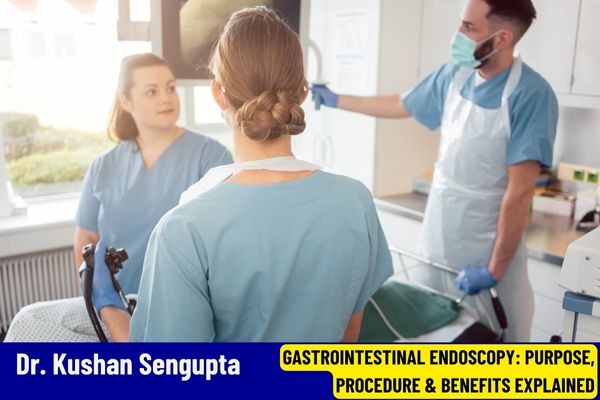Gastrointestinal Endoscopy: Purpose, Procedure & Benefits Explained
Learn what gastrointestinal endoscopy is, why it’s done, and how it helps diagnose digestive issues. Understand the procedure, benefits, and recovery process.


🔍 Understanding Gastrointestinal Endoscopy: Explained by Dr. Kushan Kaushik Sengupta
Digestive issues can be frustrating and sometimes even alarming. When symptoms persist, your doctor may recommend a Gastrointestinal Endoscopy—a powerful tool to diagnose, monitor, and sometimes treat problems inside your digestive tract.
Dr. Kushan Kaushik Sengupta, an experienced gastroenterologist, shares insights into what this procedure involves, who needs it, and how it can help you regain your health.
🩺 What is Gastrointestinal Endoscopy?
A Gastrointestinal Endoscopy is a non-surgical procedure that uses a flexible tube with a camera (endoscope) to view the inside of the esophagus, stomach, small intestine, or colon. It helps detect inflammation, ulcers, bleeding, infections, tumors, and more.
There are different types of endoscopy depending on the part of the digestive system being examined:
Upper GI Endoscopy (Esophagogastroduodenoscopy or EGD)
Colonoscopy (for large intestine)
Sigmoidoscopy
Enteroscopy
🧾 When is GI Endoscopy Recommended?
According to Dr. Kushan Kaushik Sengupta, endoscopy may be advised if you experience:
Persistent abdominal pain
Heartburn, acid reflux, or indigestion
Chronic nausea or vomiting
Blood in stool or black, tarry stools
Unexplained weight loss
Difficulty swallowing
Suspected ulcers, polyps, or cancers
Early detection through endoscopy can lead to timely treatment and better outcomes.
✅ Benefits of Gastrointestinal Endoscopy
Accurate diagnosis of GI conditions
Can perform biopsies or remove polyps during the procedure
Helps stop internal bleeding
Minimally invasive, low risk, and quick recovery
Avoids need for major surgery in many cases
⏳ What to Expect During the Procedure
Fasting for 6–8 hours before the test
You’ll receive a mild sedative for comfort
The procedure typically takes 15–30 minutes
You may experience mild bloating or sore throat afterward
Most patients go home the same day
Dr. Sengupta ensures every patient is informed and comfortable, with clear post-procedure guidance.
🧑⚕️ About Dr. Kushan Kaushik Sengupta
Dr. Kushan Kaushik Sengupta is a trusted gastroenterologist known for his expertise in advanced endoscopic procedures. He combines technology with a patient-first approach to diagnose and treat a wide range of gastrointestinal conditions with precision and care.
💬 Final Words
Don’t ignore digestive symptoms that persist. A gastrointestinal endoscopy may provide the answers—and relief—you’ve been looking for. Under the skilled care of Dr. Kushan Kaushik Sengupta, you can trust that your gut health is in the best hands.
📲 Schedule Your Endoscopy Consultation Today
Take the first step towards better digestive health with Dr. Kushan Kaushik Sengupta.